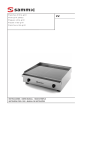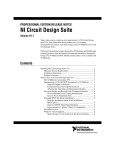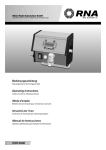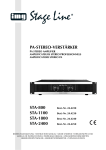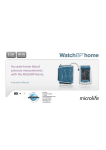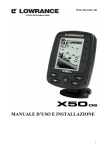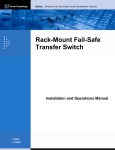Download POLAR INSTRUMENTS Toneohm 550A Operator
Transcript
Polar Instruments Ltd. Garenne Park Rue de la Cache St. Sampson Guernsey Channel Islands GY2 4AF England Fax: 44 (0)1481 52476 MAN 149-9603 TONEOHM 550A OPERATOR MANUAL TONEOHM 550A SHORTS LOCATOR OPERATOR MANUAL WARRANTY For a period of one year from its date of purchase new and undamaged from Polar Instruments Ltd, POLAR INSTRUMENTS LTD or its authorized distributors will, without charge, repair or replace at its option, this product if found to be defective in materials or workmanship, and if returned to POLAR INSTRUMENTS LTD or its authorized distributors transport prepaid. This warranty is expressly conditioned upon the product having been used only in normal usage and service in accordance with instructions of POLAR INSTRUMENTS LTD and not having been altered in any way or subject to misuse, negligence or damage, and not having been repaired or attempted to be repaired by any other than POLAR INSTRUMENTS LTD or its authorized distributors. EXCEPT FOR THE FOREGOING EXPRESS WARRANTY OF REPAIR OR REPLACEMENT POLAR INSTRUMENTS LTD MAKES NO WARRANTY OF ANY KIND, INCLUDING BUT NOT LIMITED TO, ANY EXPRESS OR IMPLIED WARRANTY OF MERCHANTABILITY OR FITNESS FOR ANY PARTICULAR PURPOSE, AND POLAR INSTRUMENTS LTD SHALL NOT BE LIABLE FOR ANY DAMAGES, WHETHER DIRECT OR NOT OR OTHERWISE, BEYOND REPAIR OR REPLACING THIS PRODUCT. Copyright Polar Instruments Ltd. 1995 DECLARATIONS TONEOHM 550A OPERATOR MANUAL ELECTROMAGNETIC COMPATIBILITY European Community Directive Conformance Statement This product is in conformity with the protection requirements of EC Council Directive 89/336/EEC on the approximation of the laws of the Member States relating to electromagnetic compatibility. A declaration of conformity with the requirements of the Directive has been signed by POLAR INSTRUMENTS (UK) LTD 11 College Place London Road Southampton England SO1 2FE This product satisfies EN50081-1:92 and EN 50082-1:92 ii SAFETY SAFETY WARNING The LIVE and NEUTRAL lines on this unit are BOTH fused. This unit contains no user-serviceable parts. When the unit is connected to its supply, the opening of covers or removal of panels is likely to expose dangerous voltages. To maintain operator safety, do not operate the unit unless the enclosure is complete and securely assembled. GROUNDING This unit must be earthed (grounded); do not operate the instrument with the safety earth disconnected. Ensure the instrument is connected to an outlet with an effective protective conductor terminal (earth). Do not negate this protective action by using an extension cord without a protective conductor. Note: This instrument is fitted with 3-wire grounding type plug designed to fit only into a grounding type power outlet. If a special local plug must be fitted to the power cord ensure this operation is performed by a skilled electronics technician and that the protective ground connection is maintained. The plug that is cut off from the power cord must be safely disposed of. Power cord color codes are as follows: Europe brown blue green/yellow live neutral earth (ground) United States black white green live neutral ground iii TONEOHM 550A OPERATOR MANUAL POWER SUPPLY Check that the indicated line voltage setting corresponds with the local mains power supply. See the rear panel for line voltage settings. To change the line voltage settings refer the instrument to a skilled electronics technician. Instructions for changing the line voltage settings are contained in the TONEOHM 550A Service Manual published by Polar Instruments. TONEOHM 550A OPERATION This manual contains instructions and warnings which must be observed by the user to ensure safe operation. Operating this instrument in ways other than detailed in this manual may impair the protection provided by the instrument and may result in the instrument becoming unsafe. Retain these instructions for later use. The TONEOHM 550A is designed for use indoors in an electrical workshop environment at a stable work station comprising a bench or similar work surface. Use only the accessories (e.g. test probes and clips) provided by Polar Instruments. The TONEOHM 550A must be maintained and repaired by a skilled electronics technician in accordance with the manufacturer’s instructions. If it is likely that the protection has been impaired the instrument must be made inoperative, secured against unintended operation and referred to qualified service personnel. Protection may be impaired if, for example, the instrument: • • • • • iv Shows signs of physical damage Fails to operate normally when the operating instructions are followed Has been stored for prolonged periods under unfavourable conditions Has been subjected to excessive transport stresses Has been exposed to rain or water or been subject to liquid spills SAFETY CAUTIONS Electrical Isolation The TONEOHM 550A must not be connected to a powered board. Make sure that the item under test is isolated from all other sources of electrical power. External power could damage the tester. NOTE: The needle probes are manufactured from very hard steel to ensure that they stay sharp. If they are used on anything other than PCBs or solder joints, take care not to press them too hard or they may snap. ENVIRONMENTAL OPERATING CONDITIONS The instrument is designed for indoor use only under the following environmental conditions: Altitude Temperature Relative humidity Mains borne transients Pollution Degree Up to 2000m +5°C to +40°C ambient RH 80% maximum at 31°C — derate linearly to 50% at 40°C As defined by Installation Category II (Overvoltage Category II) in IEC664 2 (IEC664) v TONEOHM 550A OPERATOR MANUAL SPECIFICATIONS Ranges Number of Ranges Hi sensitivity Ω 200mΩ 2Ω 200Ω 20kΩ Probe tip voltage Probe Protection 5 Approx. 40mΩ, uncalibrated 200mΩ, 4% 2Ω, 4% 200Ω, 4% 20kΩ, 4% 60mV max. Momentary contact to 100V Display 0.7”, 3½ digit Liquid Crystal Display Tone Internal speaker, headphone socket, adjustable volume Power Cord Detachable Power Requirements 230V ± 10%, 115V ± 10% or 100V ± 10% at 50/60Hz, 15VA. Physical characteristics (excluding accessories) Dimensions 300 mm (11.8 in.) wide 110 mm (4.4 in.) high 260 mm (10.3 in.) deep Weight 1.5 kg (3.3 lb.) vi SPECIFICATIONS ACCESSORIES Standard Accessories Probe set Operator manual ACC152 MAN149 SYMBOLS CAUTION — To prevent damage to this product and to ensure its safe use observe the specifications given in this manual when connecting to terminals marked with this symbol. vii TONEOHM 550A OPERATOR MANUAL CONTENTS DECLARATIONS............................................................................................................. i ELECTROMAGNETIC COMPATIBILITY...................................................................... ii European Community Directive Conformance Statement ......................................... ii SAFETY ......................................................................................................................... iii WARNING ................................................................................................................... iii GROUNDING .............................................................................................................. iii POWER SUPPLY........................................................................................................ iv TONEOHM 550A OPERATION................................................................................... iv CAUTIONS ...................................................................................................................v ENVIRONMENTAL OPERATING CONDITIONS .........................................................v SPECIFICATIONS ..........................................................................................................vi ACCESSORIES.......................................................................................................... vii Standard Accessories.............................................................................................. vii SYMBOLS .................................................................................................................. vii SECTION 1 – INTRODUCTION................................................................................... 1-1 THE TONEOHM 550A SHORTS LOCATOR............................................................ 1-1 1-1 Introduction to the TONEOHM 550A............................................................... 1-1 1-2 Areas of application......................................................................................... 1-1 SECTION 2 – GENERAL DESCRIPTION ................................................................... 2-1 PRINCIPLES OF OPERATION ................................................................................ 2-1 2-1 Locating short circuits...................................................................................... 2-1 2-2 TONEOHM 550A stimulus features ................................................................ 2-2 2-3 Controls, connectors and probes .................................................................... 2-2 Controls........................................................................................................... 2-2 RESISTANCE range switches ..................................................................... 2-2 VOLUME control .......................................................................................... 2-2 Audio tone output......................................................................................... 2-2 Connectors...................................................................................................... 2-2 Headphone socket ....................................................................................... 2-2 Probes............................................................................................................. 2-3 Needle probes ............................................................................................. 2-3 2-4 Rear Panel controls and connectors ............................................................... 2-3 SECTION 3 – INSTALLATION AND SET-UP ............................................................. 3-1 PREPARATION FOR USE ....................................................................................... 3-1 3-1 Unpacking ....................................................................................................... 3-1 3-2 Connecting the TONEOHM 550A to a power supply ...................................... 3-1 viii CONTENTS SECTION 4 – OPERATION......................................................................................... 4-1 SYSTEM OPERATION............................................................................................. 4-1 4-1 Locating short circuits...................................................................................... 4-1 4-2 Using headphones .......................................................................................... 4-2 Short location example .......................................................................................... 4-3 SECTION 5 – SIMPLE MAINTENANCE AND CLEANING ......................................... 5-1 Cleaning ................................................................................................................ 5-1 Technical Support ................................................................................................. 5-1 USER GUIDE (FRENCH) USER GUIDE (GERMAN) USER GUIDE (ITALIAN) ix SECTION 1 – INTRODUCTION THE TONEOHM 550A SHORTS LOCATOR 1-1 Introduction to the TONEOHM 550A The TONEOHM 550A Shorts Locator is a precision milliohmeter incorporating a unique resistance-dependent, variable-frequency audio tone output. This provides a fast and efficient means of pin-pointing the physical location of short circuits, both on PC boards in isolation and within circuit wiring. In many cases, short circuits may be pin-pointed to within 0.2 inches of actual fault location without the need to disconnect associated components or wiring. The sensitivity of the TONEOHM 550A allows it to be used for a wide variety of applications requiring low resistance measurements: • • • • • Continuity testing Relay and switch contact measurements Detecting and measuring high-resistance connections Measurement of transformer winding resistance Testing for shorts and partial shorts between transformer windings 1-2 Areas of application The TONEOHM 550A is an ideal instrument for a wide range of applications: • Manufacturing – goods inwards testing and troubleshooting. • PCB manufacture – locating track bridges • Field Service – fault finding. • Education – fault finding and troubleshooting training. 1-1 SECTION 2 – GENERAL DESCRIPTION PRINCIPLES OF OPERATION 2-1 Locating short circuits The TONEOHM 550A Shorts Locator is a precision milliohmmeter incorporating: • • • • A resistance-dependent, variable-frequency audio tone output. A liquid crystal display (LCD) screen providing an indication of the resistance being measured. Kelvin probes to minimise measurement errors. Low probe tip injection voltage to safeguard sensitive semiconductor devices The variable-frequency audio tone output of the TONEOHM 550A makes it especially suitable for locating for short circuits between the tracks of a PCB where hairline bridges between tracks may be hidden beneath components or even buried below the surface of the board. Using the TONEOHM 550A the technician can locate a short circuit between two tracks of a printed circuit board tracks by positioning the two Kelvin probes on the two tracks and listening for an audio tone. A tone indicates the presence of a short circuit between the tracks. The frequency of the audio tone is dependent on the resistance between the two Kelvin probes. Moving one of the probes along its track will cause the resistance between the probes to change and cause a corresponding change in the frequency of the audible tone. By moving the probe along the track until the tone reaches its highest pitch the technician will quickly locate the precise position of the short. 2-1 TONEOHM 550A OPERATOR MANUAL 2-2 TONEOHM 550A stimulus features The low probe injection voltage of the TONEOHM 550A (maximum 60mV, typically 5mV) prevents possible damage to sensitive semiconductor components within the circuit under test. The TONEOHM 550A’s DC voltage injection avoids measurement errors which could result from stray currents flowing through capacitors connected in parallel with the circuits under test. The use of Kelvin probes minimises lead loss in the measurement path. 2-3 Controls, connectors and probes Controls RESISTANCE range switches The RESISTANCE ranges (Ω, 200mΩ and 2Ω). are used to locate low resistance shorts. When locating faults on heavier tracks, use the Ω range to gain more sensitivity and resolution. Use the 200Ω, 20KΩ ranges for general resistance measurements. When using the milliohmmeter ranges, the open circuit probe tip voltage is limited to a maximum of 60mV to prevent any damage to sensitive components. VOLUME control The VOLUME control varies the sound level of the audible tone. Rotate the VOLUME control clockwise to increase the sound level. Audio tone output The TONEOHM 550A incorporates a variable-frequency audio tone output to enable the operator to maintain continuous visual contact with the circuit under test. Connectors Probe Socket Connect the Needle Probes into this socket when locating short circuits between printed circuit board tracks. Headphone socket When the headphones are connected to this socket the internal speaker is switched off and the tone switched to the headphones. Use only 3.5mm stereo jack plugs in this socket. 2-2 DESCRIPTION Probes Needle probes Place the Needle Probes across PCB tracks to locate short circuits between the tracks. 2-4 Rear Panel controls and connectors The rear panel accommodates the push button (push-on/push-off) ON/OFF mains power switch and the IEC mains inlet connector. 2-3 SECTION 3 – INSTALLATION AND SET-UP PREPARATION FOR USE 3-1 Unpacking The instrument is shipped in a sturdy transit pack. Open the pack carefully and remove the instrument and its accessories. If the instrument is damaged in any way contact the local distributor or supplier. Retain the pack for possible future use. The TONEOHM 550A pack should contain: TONEOHM 550A Power cord Pair of probes Operator manual Note: If the instrument has been shipped or stored in a cold environment, allow the instrument to reach the temperature of its new location before applying power. 3-2 Connecting the TONEOHM 550A to a power supply Refer to the voltage label on the rear panel of the instrument and make sure that the marked rating is suitable for the local mains power supply. If the rating on the label is not suitable for the local power supply refer the instrument to a skilled electronics technician. Instructions for changing the line voltage settings are contained in the TONEOHM 550A Service Manual. Note: If a special local plug must be fitted to the power cord ensure this operation is performed by a skilled electronics technician and that the protective ground connection is maintained. The plug that is cut off from the power cord must be safely disposed of. 3-1 TONEOHM 550A OPERATOR MANUAL Power cord color codes are as follows: Europe brown blue green/yellow live neutral earth (ground) United States black white green live neutral ground Check that the TONEOHM 550A mains switch (on the rear panel) is OFF. Plug the power cable into the receptacle on the rear panel of the TONEOHM 550A. Plug the other end into a wall outlet. 3-2 SECTION 4 – OPERATION SYSTEM OPERATION CAUTION: Disconnect power from the board under test before making measurements with the TONEOHM 550A Shorts Locator. 4-1 Locating short circuits • • • • • • • • Switch the TONEOHM 550A on. Rotate the VOLUME control fully clockwise. Select the desired sensitivity by pushing the associated range switch — in most cases the 200 mΩ range will be found appropriate for locating short circuits. Locate the suspect tracks and position a probe on each track. If a short exists a tone should be heard — if a tone is not heard, select a higher range to reduce the sensitivity until a tone is heard. If no tone results, the two tracks are not shorted. If a tone is heard, move one of the probes along its track — an increasing tone frequency indicates that the probe is moving towards the short, a decreasing tone frequency indicates that the probe is away from the short. Continue moving the probe in a direction that produces a higher frequency tone (and thus a lower reading), increasing the sensitivity as necessary. At the point of maximum tone frequency and minimum meter reading the probe should be within a few millimetres of the short. Visual inspection can now be employed to locate and correct the fault. In many cases it will be probably be found more convenient to locate the short initially by using the tone, then use the meter for the final resolution. In situations where tracks are heavy, more sensitivity and resolution can be gained using the lowest range. To obtain the best results and minimise damage to the track, hold the probes at right angles to the PCB and apply sufficient pressure to pierce flux and solder resist. Probe the track at different points rather than scraping the probe along its length. It is not unusual for a fault to be located between two parallel tracks where there is no visual sign of a short, even using an eyeglass. This often happens if the board is covered with solder resist, masking a hairline “whisker” short. Use a scalpel to cut 4-1 TONEOHM 550A OPERATOR MANUAL between the tracks through the solder resist and the short. An open circuit reading confirms that the fault has been cleared. A typical fault situation is shown diagramatically in Fig 4-1. 4-2 Using headphones The TONEOHM 550A incorporates the facility to output the audio tone to headphones if preferred. When the headphones are connected to this socket the internal speaker is switched off. Use only 3.5mm stereo jack plugs in this socket. A stereo to mono adapter is required for use with an earpiece. 4-2 OPERATION Short location example In the example circuit in Fig 4-1, a short circuit exists between the output of U1 and the input of U2. Board power is disconnected, and the Needle Probes are placed at A and E. The resistance of the tracks via the short gives a reading and a tone. Moving the probe from A to B gives a lower reading and a higher tone. This indicates that the probe has moved closer to the short. Moving the probe from B to C gives a higher reading and a lower tone, indicating that the probe has moved beyond the fault. This implies that the fault is between B and C. Now move the other probe from E to give the lowest reading and the highest frequency tone. When the reading is below about 15 mΩ, the probes should be within a few millimetres of the short and the tone changes to a warble. Fig 4-1 Locating a short circuit 4-3 SECTION 5 – SIMPLE MAINTENANCE AND CLEANING WARNING: This instrument should only be serviced by a qualified electronics technician. Refer all servicing to qualified service personnel. Polar Instruments publishes a TONEOHM 550A Service Manual to assist the service technician. Cleaning Clean the TONEOHM 550A with a cloth lightly moistened with water with a small amount of mild detergent. Alternatively, a cloth lightly moistened with alcohol (ethanol or methylated spirit) or isopropyl alcohol (IPA) may be used. Do not spray cleaners directly onto the instrument. Technical Support For technical support contact your local Polar Instruments distributor or Polar Instruments. 5-1 TONEOHM 550A – GUIDA PER L'UTILIZZATORE ATTENZIONE: Scollegare l'alimentazione dalla scheda da testare prima di eseguire le misure con il Localizzatore di Corto Circuiti TONEOHM 550A. Introduzione Il Localizzatore di corto Circuiti TONEOHM 550A e' un milliometro di precisione comprendente: • • Un generatore di toni Audio che varia la frequenza al variare della resistenza misurata Un Display a Cristalli Liquidi (LCD) indicante il valore della resistenza misurata L'Utilizzatore individua il corto circuito tra due piste di un circuito stampato collegando un puntale su ognuna delle due piste e ascoltando il tono audio emesso dallo strumento. Un tono indica la presenza di un corto circuito tra due piste. La frequenza del tono e' dipendente dalla resistenza misurata tra i due puntale. Muovendo uno dei due puntali lungo la pista si ottiene una variazione della resistenza misurata, a questa variazione corrisponde una variazione della frequenza del tono emesso. Il puntale deve essere spostato lungo la pista sino a che il tono raggiunge il livello piu' elevato, questa e' la posizione del corto circuito. Collegamento del TONEOHM 550A alla tensione di rete Riferirsi alla tabella delle tensioni presente sul pannello posteriore dello strumento e assicurarsi che corrisponda alla tensione di rete locale. Controllare che l'interruttore di accensione dello strumento (posto sul pannello posteriore) sia "OFF". Inserire il cavo di rete nella presa posta nel pannello posteriore del TONEOHM 550A. Inserire la spina in una presa di rete. Collegamento dei puntali Collegare i puntali "KELVIN" forniti con lo strumento nella presa dei puntali. Utilizzo della presa per la cuffia Quando la cuffia e' collegata alla presa, l'altoparlante interno viene disattivato e il tono viene inviato solo alla cuffia. Utilizzare solo connettori jack 3,5 mm stereo per questa presa. Un adattatore da stereo a mono e' necessario nel caso in cui si intenda utilizzare un auricolare. TONEOHM 550A – GUIDA PER L'UTILIZZATORE Selezione della portata Utilizzare le portate ohm, 200mohm e 2 ohm per localizzare corto circuiti a bassa resistenza. Per localizzare i corto circuiti tra piste di maggiori dimensioni utilizzare il range ohm per disporre di maggiore sensibilita' e risoluzione. Utilizzare le portate 200ohm, 20kohm per misure di resistenza generiche. Localizzazione dei corto circuiti • • • • • • • • Accendere il TONEOHM 550A. Ruotare il controllo del Volume completamente in senso orario. Selezionare la sensibilita' desiderata premendo il tasto associato alla relativa portata (generalmente la portata 200mohm risulta essere la piu' indicata per la localizzazione di corto circuiti. Localizzare le piste sospette e posizionare i puntali su ognuna di esse. Se esiste un corto circuito deve essere udito un tono, se nessun tono viene generato, selezionare una portata maggiore per ridurre la sensibilita' sino a che un tono viene udito. Se nessun tono viene emesso, le due piste non sono corto circuitate. Se viene udito un tono, muovere uno dei due puntali lungo la pista. Un incremento della frequenza del tono indica che il puntale si sta muovendo nella direzione del corto circuito. Se la frequenza del tono diminuisce significa che ci stiamo allontanando dal corto circuito. Procedere con la movimentazione del puntale nella direzione che produce la frequenza di tono maggiore (a cui corrisponde una lettura di misura inferiore), incrementando la sensibilita' se necessario. Al punto di maggiore frequenza di tono e minima lettura il puntale si trova a pochi millimetri dal corto circuito. Con una ispezione visiva possiamo ora localizzare la causa del corto circuito e rimuoverla. Generalmente e' conveniente iniziare la localizzazione del corto circuito attraverso l'utilizzo dei toni e localizzare con precisione la zona guasta seguendo le misure visualizzate sul Display a Cristalli Liquidi. Nel caso di piste con maggiori dimensioni, maggiore sensibilita' e risoluzione sono ottenute con la portata ohm. Per ottenere il risultato migliore ed evitare il danneggiamento delle piste, posizionare un puntale all'angolo destro del Circuito stampato applicando una pressione sufficiente per perforare il flussante e il "Solder Resist". Posizionare l'altro puntale in diverse posizioni della pista dopo aver raschiato le parti da misurare. Per rimuovere il corto circuito utilizzare un bisturi per incidere attraverso il "Solder Resist" il corto circuito. Una lettura di circuito aperto confermera' che il difetto e' stato rimosso. 2 TONEOHM 550A – GUIDA PER L'UTILIZZATORE Esempio di localizzazione di un corto circuito Nel circuito di esempio indicato in figura 1, esiste un corto circuito tra l'uscita di U1 e l'ingresso di U2. L'alimentazione della scheda e' scollegata e i puntali a perforazione sono posizionati nei punti A ed E. La resistenza tra le piste, per la presenza del corto circuito, offre una misura e la generazione di un tono. Muovendo il puntale da A a B otteniamo una misura inferiore e un tono maggiore. Questo significa che ci stiamo muovendo nella direzione del corto circuito. Muovendo il puntale da B a C otteniamo una lettura superiore e un tono inferiore. Questo indica che il puntale si sta allontanando dal difetto. Questo implica che il difetto e' tra B e C. Ora muovere il puntale da E in modo da ottenere un misura inferiore e una maggiore frequenza. Quando la lettura e' inferiore a 15mohm, il puntale si trova a pochi millimetri dal corto circuito e il tono si trasforma in un trillo. E U1 C CORTO CIRCUITO B A U2 Figura 1 Localizzazione di un corto circuito 3 TONEOHM 550A KURZANLEITUNG ACHTUNG: Entfernen Sie jegliche Spannungsversorgung vom Testobjekt, bevor Sie mit Tests mit dem TONEOHM 550A beginnen ! Einführung Der TONEOHM 550A Kurzschlußlokalisator ist ein Präzisions-Milliohmmeter mit folgenden zusätzlichen Funktionen: • • Ein widerstandsabhängiger, frequenzvariabler Audio-Tongenerator Eine Flüssigkristallanzeige (LCD) als Anzeiger für den gemessenen Widerstandswert Der Anwender lokalisiert den Kurzschluß zwischen zwei Leiterbahnen einer Platine durch Kontaktieren jeder dieser Leiterbahnen mit einer Prüfspitze, wobei der Ton zum Kurzschlußpunkt führt. Ein hörbarer Ton zeigt generell die Existenz eines Schlusses zwischen den Leiterbahnen an. Die Tonhöhe hängt dabei vom Widerstandswert zwischen den beiden Prüfspitzen ab. Das Bewegen einer der beiden Spitzen ändert den Widerstandswert und damit die Tonhöhe. Die Prüfspitze wird so lange entlang der Leiterbahn positioniert, bis die höchste Tonhöhe gefunden ist. Anschluß des TONEOHM 550A an die Netzversorgung Vergewissern Sie sich, ob die auf der Geräterückseite aufgedruckte Netzspannung mit der lokalen Netzversorgung übereinstimmt ! Überprüfen Sie, ob der Netzschalter des TONEOHM 550A (auf der Geräterückseite) in der Stellung OFF steht. Schließen Sie nun das Netzkabel in die zugehörige Buchse auf der Geräterückseite an. Stecken Sie zuletzt den Netzstecker in eine Wandsteckdose. Anschluß der Prüfspitzen Schließen Sie die beiliegenden Kelvin-Prüfspitzen an die vorgesehenen Anschlußbuchsen an. Anwendung des Kopfhöreranschlusses Wird an die Buchse ein Kopfhörer angeschlossen, so wird der eingebaute Lautsprecher abgeschaltet und der Ton auf die Kopfhörer geleitet. Verwenden Sie ausschließlich Kopfhörer mit 3,5mm Stereoklinkenstecker. Für Ohrhörer ist ein Stereo zu Mono-Adapter erforderlich. Auswahl des Bereichs Wählen Sie den Bereich Ω ,200mΩ und 2Ω, wenn Sie niederohmige Kurzschlüsse auffinden wollen. Wollen Sie Schlüsse auf sehr breiten Leiterbahnen auffinden, so bietet der Bereich Ω die beste Auflösung und Empfindlichkeit. Die höherohmigen Meßbereiche 200Ω und 20KΩ wurden für übliche Widerstandsmessungen implementiert. 0-1 T OPERATOR MANUAL Lokalisieren von Kurzschlüssen • • • • • • • • Schalten Sie den TONEOHM 550A ein Drehen Sie den Lautstärkesteller VOLUME auf Rechtsanschlag Wählen Sie die gewünschte Empfindlichkeit durch Drücken des zugehörigen Bereichsschalters - in den meisten Fällen ist den 200mΩBereich der geeignete Bereich für die Kurzschlußsuche Lokalisieren Sie die verdächtigen Leiterbahnen und kontaktieren Sie beide mit je einer Prüfspitze Existiert ein Kurzschluß, so sollte ein Ton hörbar sein - ist kein Ton zu hören, so wählen Sie einen höheren Bereich, um die Empfindlichkeit zu reduzieren, bis ein Ton hörbar ist. Gibt das Gerät weiterhin keinen Ton von sich, ist kein Kurzschluß vorhanden Ist ein Ton hörbar, bewegen Sie eine der beiden Prüfspitzen entlang der Leiterbahn - eine ansteigende Tonhöhe zeigt an, daß die Prüfspitze zum Kurzschlußpunkt hin bewegt wird; sinkt die Tonhöhe, wird sie vom Fehlerpunkt entfernt Setzen Sie fort, die Prüfspitzen in die Richtung der ansteigenden Tonhöhe zu bewegen, und erhöhen Sie bei Bedarf die Empfindlichkeit Am Punkt der höchsten Tonhöhe und des geringsten Anzeigewerts sollten die Prüfspitzen nur mehr einige wenige Millimeter vom Kurzschlußpunkt entfernt sein. Durch visuelle Kontrolle kann nun der Fehler geortet und anschließend behoben werden. Meist ist es ratsam, den Kurzschluß zu Beginn der Messung nur durch Beachten der Tonhöhe einzugrenzen, später liefert die Anzeige eine genauere Auflösung. In Fällen von sehr dicken Leiterbahnen ist der Ω-Bereich aufgrund seiner großen Empfindlichkeit am besten geeignet. Um beste Ergebnisse bei gleichzeitig geringster Beschädigung der Leiterbahnen zu erreichen, ist es ratsam, die Prüfspitzen rechtwinkelig mit mäßigem Druck auf die Leiterbahnen aufzusetzen, um Lötrückstände und Lötstoppoberflächen zu durchdringen. Prüfen an verschiedenen Punkten ist einem Entlangkratzen an den Leiterbahnen vorzuziehen. Verwenden Sie ein Skalpell, um den Schluß zwischen den Leiterbahnen durch die Lötstoppschicht hindurch aufzutrennen. Eine abschließende Messung (Leerlauf) sollte die Behebung des Fehlers bestätigen. 0-2 INTRODUCTION Beispiel einer Kurzschlußlokalisierung In Abb. 1 existiert ein Schluß zwischen dem Ausgang von U1 und dem Eingang von U2. Die Versorgung der Platine wurde entfernt, und die Prüfspitzen wurden auf die Punkte A und E aufgebracht. Der geringe Widerstandswert zwischen den beiden Leiterbahnen bewirkt eine Anzeige am Display bzw. einen hörbaren Ton, hervorgerufen durch den Kurzschluß. Durch Ändern der Prüfspitzenposition von A nach B wird der angezeigte Wert kleiner, der Ton wird höher. Dies bedeutet, die Spitze wurde zum Kurzschlußpunkt hin bewegt. Wird die Spitze weiter von B nach C bewegt, so steigt der angezeigte Wert an, der Ton wird wieder tiefer, d.h. die Spitze wurde wieder vom Fehlerpunkt entfernt. Der Fehler liegt also zwischen B und C. Nun ist die Position der anderen Prüfspitze so lange zu verändern, bis der Anzeigewert ein Minimum bzw. die Tonhöhe ein Maximum ist. Ist der Wert ca. unter 15mΩ, so sind beide Prüfspitzen nur wenige Millimeter vom Kurzschlußpunkt entfernt, der Ton beginnt zu intermittieren. E U1 C CORTO CIRCUITO B A U2 Abb. 1 Lokalisieren eines Kurzschlusses 0-3 TONEOHM 550A USER GUIDE CAUTION: Disconnect power from the board under test before making measurements with the TONEOHM 550A Shorts Locator. Introduction The TONEOHM 550A Shorts Locator is a precision milliohmmeter incorporating: • • A resistance-dependent, variable-frequency audio tone output. A liquid crystal display (LCD) screen providing an indication of the resistance being measured. The operator locates short circuits between two tracks of a printed circuit board by connecting a probe to each track and listening for an audio tone. A tone indicates the presence of a short circuit between the tracks. The frequency of the tone is dependent on the resistance between the probes. Moving one of the probes along its track will cause the resistance between the probes to change and cause a corresponding change in the frequency of the tone. The probe is moved along the track until the tone reaches its highest pitch, which is the position of the short. Connecting the TONEOHM 550A to a power supply Refer to the voltage label on the rear panel of the instrument and make sure that the marked rating is suitable for the local mains power supply. Check that the TONEOHM 550A mains switch (on the rear panel) is OFF. Plug the power cable into the receptacle on the rear panel of the TONEOHM 550A. Plug the other end into a wall outlet. Connecting the Probes Connect the Kelvin Probes supplied with the instrument into the Probe Socket. Using the headphone socket When the headphones are connected to this socket the internal speaker is switched off and the tone switched to the headphones. Use only 3.5mm stereo jack plugs in this socket. A stereo to mono adapter is required for use with an earpiece. Selecting the range Use the Ω, 200mΩ and 2Ω ranges to locate low resistance shorts. When locating faults on heavier tracks, use the Ω range to gain more sensitivity and resolution. Use the 200Ω, 20KΩ ranges for general resistance measurements. 1 TONEOHM 550A USER GUIDE Locating short circuits • • • • • • • • Switch the TONEOHM 550A on. Rotate the VOLUME control fully clockwise. Select the desired sensitivity by pushing the associated range switch — in most cases the 200 mΩ range will be found appropriate for locating short circuits. Locate the suspect tracks and position a probe on each track. If a short exists a tone should be heard — if a tone is not heard, select a higher range to reduce the sensitivity until a tone is heard. If no tone results, the two tracks are not shorted. If a tone is heard, move one of the probes along its track — an increasing tone frequency indicates that the probe is moving towards the short, a decreasing tone frequency indicates that the probe is away from the short. Continue moving the probes in a direction that produces a higher frequency tone (and thus a lower reading), increasing the sensitivity as necessary. At the point of highest pitch and minimum meter reading the probes should be within a few millimetres of the short. Visual inspection can now be employed to locate and correct the fault. It is usually most convenient to locate the short initially by using the tone, then use the meter for the final resolution. In situations where tracks are heavy, more sensitivity and resolution can be gained using the Ω range. To obtain the best results and minimise damage to the track, hold the probes at right angles to the PCB and apply sufficient pressure to pierce flux and solder resist. Probe the track at different points rather than scraping the probe along its length. To remove the short use a scalpel to cut between the tracks through the solder resist and the short. An open circuit reading confirms that the fault has been cleared. 2 TONEOHM 550A USER GUIDE Short location example In the example circuit in Fig 1, a short circuit exists between the output of U1 and the input of U2. Board power is disconnected, and the Needle Probes are placed at A and E. The resistance of the tracks via the short gives a reading and a tone. Moving the probe from A to B gives a lower reading and a higher tone. This indicates that the probe has moved closer to the short. Moving the probe from B to C gives a higher reading and a lower tone, indicating that the probe has moved beyond the fault. This implies that the fault is between B and C. Now move the other probe from E to give the lowest reading and the highest frequency tone. When the reading is below about 15 mΩ, the probes should be within a few millimetres of the short and the tone changes to a warble. Fig 1 Locating a short circuit 3 TONEOHM 550A – GUIDE UTILISATEUR ATTENTION : Déconnecter l'alimentation de la carte sous test, avant d'effectuer des mesures de résistances Introduction Le localisateur de courts-circuits TONEOHM 550A est un milliohmètre de précision qui intègre : • • Un signal sonore à tonalité variable en fonction de la résistance Un afficheur à cristaux liquide qui donne une indication de la valeur mesurée Le technicien localise le court-circuit entre pistes en positionnant ses sondes sur les pistes et en écoutant la tonalité du signal sonore. Une tonalité particulière indique la présence du court-circuit. La fréquence du son dépend de la valeur de la résistance mesurée. Le déplacement des sondes le long des pistes fait varier la résistance mesurée, ce qui produit une variation de la tonalité. La sonde est déplacée le long de la piste jusqu'à ce que l'on atteigne le son le plus aiguë, indiquant le point de court-circuit. Branchement du TONEOHM 550A au secteur Vérifier que la tension d'alimentation secteur indiquée à l'arrière de l'appareil est conforme à celle utilisée. Assurez-vous que l'interrupteur marche/arrêt, à l'arrière du TONEOHM 550A est en position OFF. Connecter le cordon secteur à l'appareil. Connexion des sondes Brancher les sondes de mesure Kelvin à la prise DIN de la face avant. Utilisation d'un casque Lorsqu'un casque d'écoute est branché à la prise jack, le haut parleur interne est automatiquement coupé. Utiliser seulement une prise jack stéréo de 3,5mm. Un adaptateur stéréo/mono sera nécessaire si l'on utilise un écouteur simple. Sélection des gammes Choisir les gammes Ω, 200mΩ et 2Ω pour la localisation des courts-circuits francs. Dans la situation de pistes larges et peu résistives, sélectionner plutôt la gamme Ω pour gagner en sensibilité et résolution. Les gammes 200Ω et 20kΩ sont destinées à un usage général. TONEOHM 550A – GUIDE UTILISATEUR Localisation des courts-circuits • • • • • • • • Mettre le TONEOHM 550A en marche (sur ON). Tourner le potentiomètre OFF-ON VOLUME à fond. Sélectionner la gamme de sensibilité choisie - Dans la plupart des cas la gamme 200 mΩ est la plus appropriée pour les courts-circuits francs. Repérer les pistes suspectes et positionner une sonde sur chacune des pistes. S'il existe un court-circuit, on doit entendre un signal sonore. Dans la négative, changer de gamme pour obtenir le son. S'il n'y a aucun signal, c'est l'indication que les pistes ne sont pas en court-circuit. Si un signal sonore est généré, déplacer une des deux sondes le long de sa piste - l'augmentation de la fréquence sonore indique que l'on se rapproche du défaut et sa diminution indique que l'on s'éloigne. Continuer à se déplacer dans la direction qui produit un son aiguë. Le court-circuit se trouve au point qui donne le son le plus aiguë et la valeur affichée minimum. Inspecter visuellement l'endroit pour localiser le défaut. Dans beaucoup de situations, il sera plus facile de localiser le défaut en se fiant d'abord au signal sonore puis d'affiner ensuite la mesure avec l'afficheur LCD. Dans le cas de pistes larges et peu résistives, on peut augmenter la sensibilité en utilisant la gamme la plus faible ( Ω ). Tenir les sondes verticalement pour éviter d'endommager la piste et obtenir le meilleur résultat. Sonder à différents points plutôt que de faire glisser la sonde le long de la piste. La suppression du court-circuit peut se faire à l'aide d'un scalpel, en coupant entre les pistes, à travers le vernis. 2 TONEOHM 550A – GUIDE UTILISATEUR Exemple de localisation L'exemple de la figure 1 illustre le cas d'un court-circuit entre la sortie U1 et l'entrée de U2. L'alimentation de la carte est débranchée et les pointes de touche sont placées aux points A et E. La faible résistance entre les pistes via le court-circuit est visible sur l'afficheur et génère un signal sonore. En déplaçant la pointe de touche de A vers B, le signal sonore augmente en fréquence et la valeur affichée diminue. Cela indique un rapprochement vers le point de courtcircuit. Le déplacement de B à C donne un signal sonore plus grave, qui indique que l'on a dépassé le défaut. Cela implique que le court-circuit est entre B et C Déplacer maintenant l'autre pointe de touche pour obtenir le son le plus aigu possible. dès que la valeur mesurée descend en dessous de 15mΩ, le son devient discontinu et le point de court-circuit est à quelques millimètres. E U1 C COURT-CIRCUIT B A U2 Fig.1 localisation d'un court-circuit 3


































